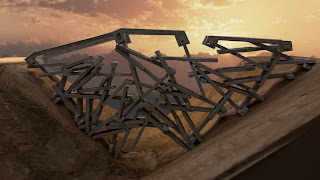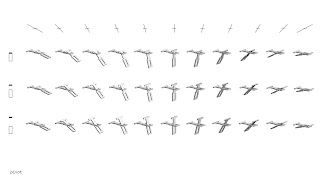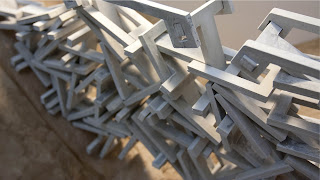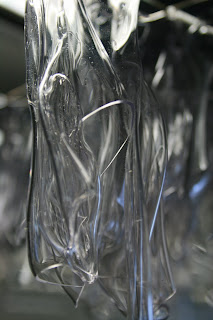
Wednesday, March 31, 2010
Relationship Between Experimentation and Theory
The question of the relationship between experimentation and theory is a sub-set of the larger question: what is the relationship between action and thought? The answer is: thought drives action, and it is subsequently informed by action. This is the core lesson of the feedback loop. To act effectively, we must guide our actions with knowledge acquired from our observations of the world, and to enhance and expand our knowledge of the world, we must engage it in action. We must explore and discover. The relationship between action and thought is not unilateral, in which one element dominates the other, because we are integrated beings, possessing both a body and mind. We need both to survive and to thrive. To paraphrase Ayn Rand: A body without a mind is a zombie, and a mind without a body is a ghost. Both are archetypes of the undead.
Experimenting is an action. It is a way of doing the work of design. Its antithesis is perpetuating, which is the mainstream’s dominant way of working. That is a different action. So the question really is: what ideas (i.e., what theories) are coupled with these actions? What are the ideas that complete the necessary coupling of action and thought in the work of architects? Perpetuating … what? Experimenting … for what? Experimenting is pointless as an end-in-itself. It must be directed, guided by a curiosity about something. It is always guided by an idea (explicit or implicit) about what is important to explore and discover about the world. In other words, every act of experimentation implies a value-judgment – a choice to explore this as opposed to that, which implies that the selected subject of experiment is more important than alternative subjects not pursued. Every act of experimentation expresses a view of the world – a view of what is important about the world or life in it.
Perpetuating is the same. What does one choose to perpetuate? Every act of perpetuation involves a choice, and thus, it too expresses a view of what is important.
So what have you been experimenting with in your projects this semester? What aspects of the world have been drawn out and accentuated? What conventions have you accepted and perpetuated in your work this semester? Answering these questions will lead you toward an understanding of the view of the world embodied in your work. It is a good way to begin to see what your work means.
Monday, March 29, 2010
Article from national discussion on thesis
Thursday, March 25, 2010
Project: FireFly
plastic components (pictures coming soon), which will then be assembled into larger groups that
will in turn make up our ceiling prototype. We have access to an unlimited number of plans and
must make some design decisions about how the overall expression develops.
would be interesting to try a voronoi but I think it will express stability. I for one, am interested in
movement, so we will see how the project unfolds. Notice how the plan above varies between static
and dynamic with subtle changes such as tangential alignment or simple moves like shifting the
regulating point lists.
Although the video is at 8x speed, it is sooooooo slow; I did not have great access to movie
software at this time and will have to do better next time. Hopefully there will be more to come
(and more elegant videos) as the plan gets applied to 3 dimensions.
Monday, March 15, 2010
Saturday, March 13, 2010
Your Old Fashioned Covered Bridge
Friday, March 12, 2010
Wednesday, March 10, 2010
theories beyond experimental practice?
If the above is true: when / how does theory become integrated as a representation of society? Or is it only after the tangible fact of experimentation that theory can be tested as a manifestation?
If theory exists at the same time as experimental practice, which it probably does, how can we avoid using theory to rationalize what we do, after the fact?
Or does theory come before practice? I think understanding how to integrate the thought is relevant to the development of process.
If we use the methodology behind modern scientific theory as a motivational factor (the postulate first, then prove), then theory directs experimentation. Thus, we need to establish theory to drive our designs.
Is that where conviction comes into the picture?
Regulation of Energy comment
But Kyle, they make it so easy to just check boxes and achieve Platinum certification! Why would you even bother to learn why any of those thinks work?
Think about the idiot light in the car you drive everyday. Do you need to know what the little oil can light means? Or do they just put an all encompassing check-engine light on the dash board now? Regardless, when the light comes on, we now have only the choice to either take it to the dealer or to another “specialist” to get fixed. They are the experts...
So what does that say about the significance we put on design? Are architects supposed to be the experts? The public need not know, they are protected from themselves by experts.
If the energy consumption in a building is too high, the architect is responsible, by code.
Does the Toyota chassis designer know the specifics underlying internal combustion engines and the computers running them? Or does he only understand the size and torque of the engine?
I think he works on part of a team, no? The team is working together to produce a highly sophisticated machine (ok, maybe not a Toyota).
Does the establishment of codes make the Toyota chassis designer, if he were an architect, responsible for cars speeding out of control on the interstate? I think general knowledge is a good think, in fact, the quest for knowledge is probably my curse, but it is difficult to know it all. As an analogy, I think it is better to hire a plumber when you need a plumber, hire an engineer when you need an engineer and a designer when you need something designed. However, I still need to know if the plumber can do his job well....
Structure and Image
This is a courageous and multifaceted question: a juicy one. Let me start by saying that I was happy with the studio’s results from Project 2. It was a difficult exercise that asked you to re-balance many aspects of your design thinking, and to introduce a few new aspects altogether. In fact, it seems it was too much to bite off. This is always a pedagogical danger when trying out a new project. Few people got their heads around the jig as mechanism of analog-based parametric design, for example, and jigs did not play the central role in creative exploration I had hoped they would.
Another deviation from the project pedagogy was the failure of many folks to engage the bridge as a structure. Few people took the bridge’s need for structural stability seriously, and the result was many bridges that are structurally weak. Instead, the focus shifted toward: material-based research (continuing the process from Project 1), componentization, tectonics and propagating components into a larger structural pattern. These were all crucial issues to tackle and digest prior to Project 3, so I consider the project a success. But there is that nagging neglect identified in the question: what about structure? It seems to me that there is some interesting psychological dimension to this neglect. I was surprised to find that even when I tried to reassert the importance of rigidity and lateral bracing, few seems to get serious about resolving these things. If students had taken seriously these structural requirements, nearly every project would have looked radically different.
I have reflected on this a bit since the end of Project 2, and I believe the cause is, in part, confusion regarding modeling versus prototyping. What were we doing in Project 2? Were we building a scale representation of a bridge, or a real, structural, spanning artifact out of tubing, wood or Rockite? To the extent a student saw it as a scale model representing a bridge, it became a non-structural, merely visual study. In other words, issues of structure receded and issues of appearance dominated. To the extent a student saw it as a material artifact in its own right, it became a structural entity that needed to support itself, become rigid, and make it across the gap. In this regard, the two projects that best captured this real-thingness approach, and produced the most structurally authentic results were Tom’s Rockite House of Cards and Brandon’s Wax Cactus. Strangely it was Rockite and wax, which seemed most difficult in the early days of the effort, that might have played a role in getting people into a truly structural frame of mind. These two projects do not just look structural, they are structural, and it was the weight of the material itself that led to an unavoidable need to treat it as such.
In response to this realization, I have already made a change to Project 2, in the event I reuse it next year. Two new requirements: 1) bridge must support a brick, and 2) bridge must reduce lateral deflection to maximum 1/4” when a box fan is placed next to it and turned on high. Heavier materials have a harder time with requirement #1 and an easier time with #2, and vice versa for light-weight materials. These rules will make confronting the realness of the artifact unavoidable. Architects are traditionally so well trained to avoid realness, to avoid direct, empirical study of material things, that the tendency is to treat everything as a representation of something else. The goal of this studio, in contrast, is to treat everything as a real thing, even model-scale representations. It seems to me that this is a radical kind of authenticity, which makes the second aspect of the questioner’s concern even more interesting.
The second aspect expresses concern about the studio’s focus on diagram-making, and especially on the final review for Project 2, which focused on diagrams and image layout. Are we getting lost in the making of “sexy graphics”? What is more important, the design of a bridge or the design of an image layout? From my perspective I would say that they are both very important, and it would be deadly to neglect one or the other. In my experience, students at our school are given weak education in visual communication, and in some cases, they are even given a mis-education: taught to manage visual information in self-defeating ways. I find it necessary to give students a contrary perspective on visual communication as well as other aspects of design process. It is part of the studio’s ground-up critical redirection of the architectural education status quo.
Part of the problem is that students are taught (sometimes tacitly, sometimes overtly) that the way you present visual information is irrelevant, that only the content of your presentation is important. But content and method are interdependent, and the fact is that the way you present ideas visually has a huge impact on how your design will be understood and evaluated. Our students lose many professional opportunities merely because their method of visual communication is clumsy, and it expresses the operation of a clumsy, naïve mind. How you present something conveys complex messages about you: the clarify of your thinking, your degree of self-discipline, your level of confidence, your level of passion, and your degree of empathy for others. I say that our students’ visual information is often "naïve" because they do not understand that all these things are conveyed in a page layout, and because they do not know it, they inadvertently convey horrible, off-putting things about themselves. The studio’s agenda of diagramming and visual communication seeks to show you that even subtle choices about graphic layout are choices, and they convey something about you, for better or worse, and to professional designers, who are acutely attuned to visual things, it conveys a lot about you, for better or worse.
Perhaps the biggest weakness of our students with regard to visual communication is lack of empathy. Students at our school routinely produce visual content that makes it very clear that they do not care at all whether anybody can understand it. They have no empathy for their audience, so little in fact, that they usually do not ever stop to ask: Will people understand what I am trying to show? What will they likely glean from it? What are they most likely to miss, and how might I correct that? What aspects are confusing and why? Is anything vague, and how could I clarify it? Students usually do not realize how powerful it is to see something clear and true. This happened once during the Project 2 final review when Dace remarked with fervor how clear and true Michelle’s layout was. When information connects with an observer, it is powerful. This is visual authenticity: the clear and true portrayal of your design content. Yes, authenticity is important in the content of designs, but it is no less important in the method of conveying them. What we are seeking in this studio is both kinds of authenticity, which cannot really exist apart.
Content is important, but content can never be conveyed and understood except through some means. It is dangerous to undermine the importance of visual means as mere appearance, as sexy graphics. One’s visual medium is the only path to one’s content. Belittle the path and you belittle the content.
The Post Modern slogan "the medium is the message" (translation: the method is the content) is dead. This was an attempt to negate content and raise visual method to a status of sole concern, in which discussion of "sexy graphics" was self-sufficient. But do not fall into the opposite trap, believing that visual method is dead. We need both. The crux of newer thinking is that design content and visual method are interdependent.
Having said this, I will also say that in the studio there is always a day, usually during Project 2, when everybody shows their diagrams and layouts for the first time. It is an important moment of feedback when I try to help students make some important connections to the previous diagramming lectures. But I have said pretty much all I want to say on that. I am happy to look at individual diagrams and layouts and provide feedback as we move forward, but we will mostly move on to other concerns.
Regulation of Energy
LEED began as a voluntary system used to assess energy conservation through accumulation of points. It has become a mandate of political correctness in corporate practice, and it promises to become a requirement of licensure. Thereafter it could become a model for the first energy conservation building code, involving a massive expansion of the already massive regulatory bureaucracy governing the building industry.
Even if this future does not befall us, LEED is already beginning to have the effect of other building codes. Architects used to be experts in fire safety; now they are experts in the application of building codes. They often have no idea what a code means or why it was invented. (Even Building Inspectors and other code officials often do not know why a code was invented, since the code does not contain its own history and justification.) Architects only know that they must comply, so the question of the relationship between the code and fire safety is irrelevant. The same effect of regulation can be seen in the government-run high schools, which now predominately teach to standardized tests. Instead of conveying real knowledge to students in a way that prepares them for life, they convey statistically probable test information in a way that prepares them for the SAT.
Architects, currently compelled by social pressure and in the future compelled by the government, learn the rules and regulations of LEED to become certified, rather than the principles of energy efficiency. In this case too, compliance with a regulatory bureaucracy replaces real understanding. This is the pattern of government bureaucracy: it poses as the protector of some aspect of life, be it education, fire safety or energy conservation, and then promptly displaces this aspect of life, pushing regulatory rules into the foreground of our minds, and pushing life to the periphery. Wisdom in the nature of childhood learning, combustibility, and energy consumption is replaced by wisdom in compliance to an ever-expanding tapestry of rules. This gradual substitution of government for life is the inevitable result of regulatory bureaucracy, since a mind cannot be regulated. Government cannot force a person to understand. Government cannot force a person to master the principles of energy conservation, only to conform to a point system, and these are far from equivalent. Because LEED plays a growing role in this process of dumbing-down our profession, I do not support it. Or put another way, I do not support LEED because I believe architects need to understand the principles of energy efficiency.
Materials Research and Parametric Techniques
It depends on whether by “today’s practice” you mean mainstream practice or experimental practice. If you mean experimental practice, then I would say that materials research and parametric techniques are not “influencing” today’s experimental practice – they are today’s experimental practice. They are the methodological backbone of the practice. They are the means of such practice. Another way to say it: today’s experimental practice is the practice of materials research and parametric techniques. There is certainly more to contemporary work than these two methods, but nonetheless, much of what experimental designers do, falls into one or both of these methodological categories. This is why it is crucial for young designers to master these methods, if they want their work to be seen as relevant and their skills to be seen as valuable to experimental practitioners who might employ them.
Tuesday, March 9, 2010







 The component, acting as jig, is inherently variable in assembly and static in dimension. Through the use of quantity, angle, and distance, the component generates an anarchic patterning. Construction of the bridge relied heavily on attempting to apply the forces of compression parallel to the joint. Perpendicular compression on the [t] to the [o] joint resulted in structural failure. Remnants of fallen heros remain in the bridge construction as removal was tedious and destructive to the rest of the bridge structure.
The component, acting as jig, is inherently variable in assembly and static in dimension. Through the use of quantity, angle, and distance, the component generates an anarchic patterning. Construction of the bridge relied heavily on attempting to apply the forces of compression parallel to the joint. Perpendicular compression on the [t] to the [o] joint resulted in structural failure. Remnants of fallen heros remain in the bridge construction as removal was tedious and destructive to the rest of the bridge structure.The first artifacts and prototypes edges were shear and flat. To generate more component connection possibilities I made the decision to extend the [t] beyond the width of the [o]. This is what led to the connection of the implied walking surface. The surface would be constructed out of a sort of grate material to allow for views to the structure below. The inspiration for the patterning was retrieved from a meteorite cross-section, showing the Widmanstätten patterning.













































